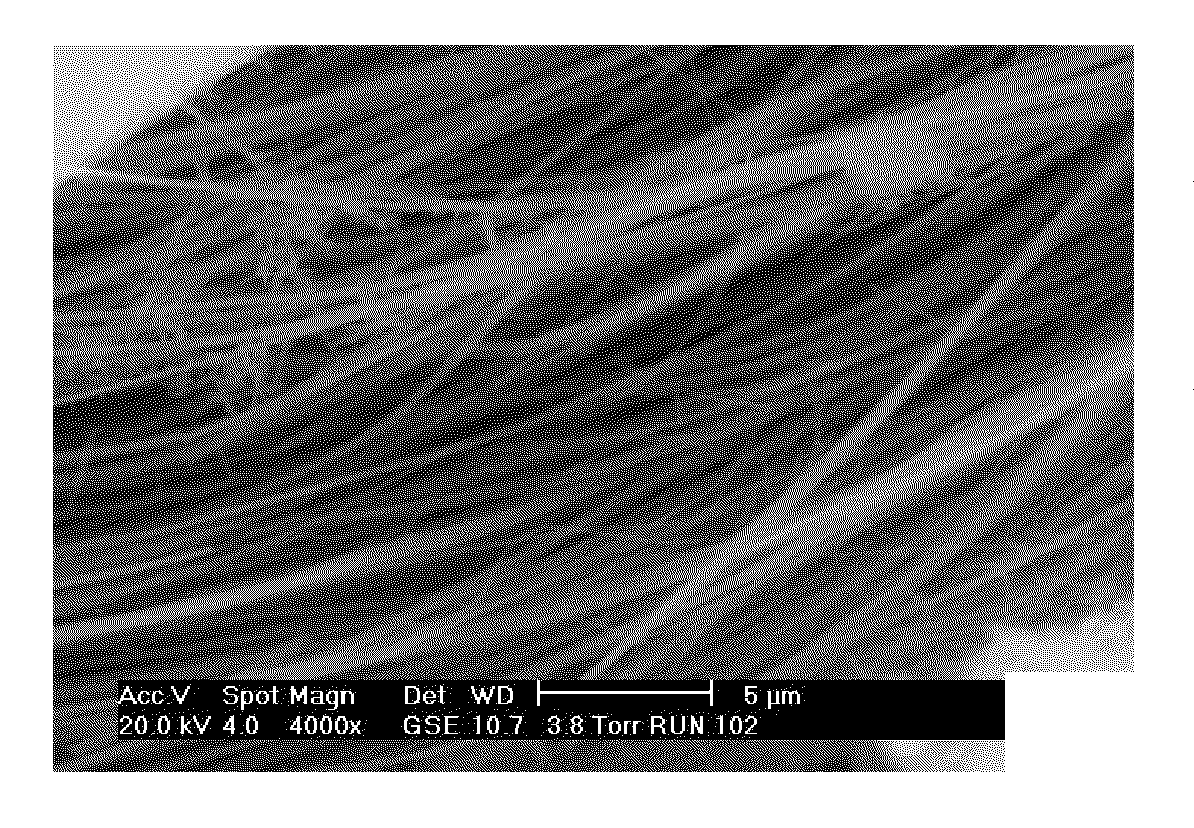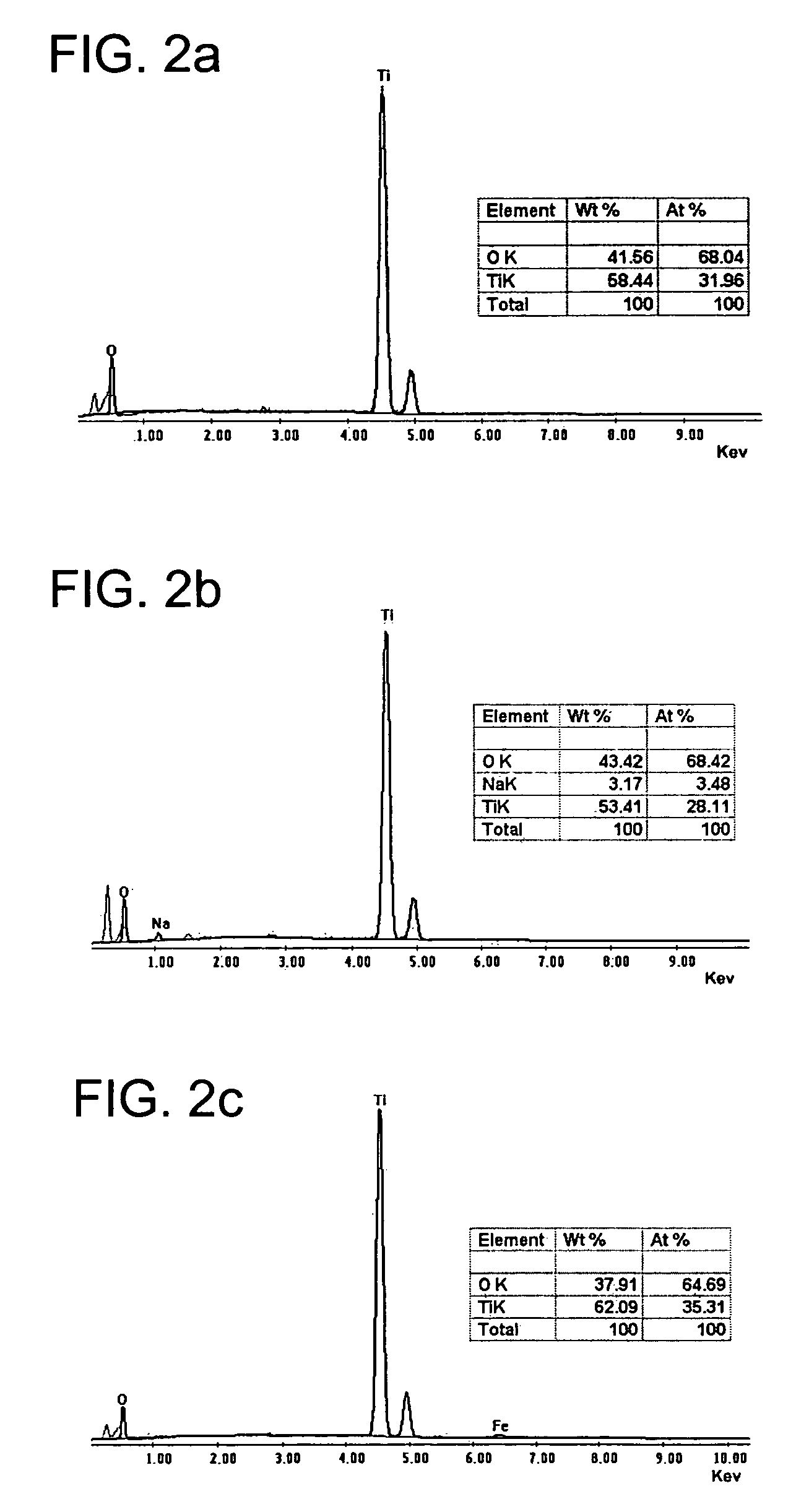Nanostructured titanium oxide material and its synthesis procedure
a titanium oxide and nanotube technology, applied in nanotechnology, nanotechnology, inorganic chemistry, etc., can solve the problems of limited use of macroroporous solids as adsorbers or catalysts, limited effectiveness of macroroporous solids as catalysts, limiting the use of adsorbents and/or ionic exchange systems, and wide pore distribution, etc., to achieve stable nanotubular structure and high specific area
- Summary
- Abstract
- Description
- Claims
- Application Information
AI Technical Summary
Benefits of technology
Problems solved by technology
Method used
Image
Examples
examples
[0090]The following examples show production of titanium oxide nanomaterials with the crystalline structure TiO2-x JT phase, where 0≦x≦1, that are thermally stable and that are produced from a precursor of hydrogen titanate and / or mixed sodium and hydrogen titanate with orthorhombic structure with our synthesis procedure. The molar ration NaOH / TiO2 used is in the range of 7 to 70 M, preferably 10 to 60 M, which includes a ratio H2O / TiO2 of 50 to 410 M, preferably 80 to 300 M. The examples are illustrative of the present invention, and are not intended to limit the scope of the invention.
examples 1 to 7
[0091]Examples 1 to 7 illustrate the preparation of the nanotubes of hydrogen titanate and / or mixed sodium and hydrogen titanate which are isostructural to the structure TiO2-x JT phase, where 0≦x≦1, starting from titanium oxihydroxide (with a crystal size smaller than 3 nm, a specific area of 190 m2 / g, a pore volume of 0.22 cm3 / g, and an average pore diameter of 4.7 nm), prepared by the sol-gel method and under the synthesis modality involving a hydrothermal treatment, aim of the present invention.
[0092]1.5 g of amorphous titanium oxihydroxide, obtained by the sol-gel method, is placed in contact with 100 cm3 of a 5 to 20 M alkaline solution of sodium hydroxide. Each of the prepared suspensions in examples 1 to 7 was poured in a closed vessel. In Table 1, the different temperatures used in the synthesis for each example are specified, within an interval from 100° C. to 180° C., and during a reaction time between 12 and 96 hours.
[0093]The resulting materials from each example is sub...
examples 8 to 15
[0098]Examples 8 to 15 illustrate the preparation of the nanotubes and / or nanofibers of hydrogen titanate and / or mixed sodium and hydrogen titanate; starting from a titanium oxide (with anatase crystalline structure, a crystal size of 8 nm, an average particle diameter between 0.5 and 2.5 μm, a specific area of 102 m2 / g, a pore volume of 0.51 cm3 / g, and a pore diameter of 11.3 nm) and using a synthesis procedure which involves a thermal treatment under reflux conditions, aim of the present invention.
[0099]7.5 g of titanium oxide with anatase structure is placed in contact with 500 cm3 of a 5 to 20 M aqueous solution of sodium hydroxide. Each of the prepared suspensions in Examples 8 to 14 was submitted to a thermal treatment, under reflux conditions, at a temperature between 80° C. and 110° C. In Table 3, it is specified the reaction time and temperature used in each example. The time interval is between 3 and 48 hours. Only in the case of the Example 15 the formed suspension, conta...
PUM
| Property | Measurement | Unit |
|---|---|---|
| length | aaaaa | aaaaa |
| length | aaaaa | aaaaa |
| length | aaaaa | aaaaa |
Abstract
Description
Claims
Application Information
 Login to View More
Login to View More - R&D
- Intellectual Property
- Life Sciences
- Materials
- Tech Scout
- Unparalleled Data Quality
- Higher Quality Content
- 60% Fewer Hallucinations
Browse by: Latest US Patents, China's latest patents, Technical Efficacy Thesaurus, Application Domain, Technology Topic, Popular Technical Reports.
© 2025 PatSnap. All rights reserved.Legal|Privacy policy|Modern Slavery Act Transparency Statement|Sitemap|About US| Contact US: help@patsnap.com



